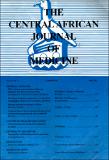| dc.contributor.author | Mbizvo, M.T. | |
| dc.contributor.author | Kasule, J. | |
| dc.contributor.author | Mahomed, K. | |
| dc.contributor.author | Nathoo, K. | |
| dc.coverage.spatial | Zimbabwe | en |
| dc.date.accessioned | 2015-06-22T09:07:20Z | |
| dc.date.available | 2015-06-22T09:07:20Z | |
| dc.date.issued | 2001-05 | |
| dc.identifier.citation | Mbizvo, M.T. [et al ] (2001) HIV-1 Seroconversion Incidence Following Pregnancy and Delivery Among Women Seronegative at Recruitment in Harare, Zimbabwe, CAJM vol. 47, no. 5. (pp. 115-8) UZ, Avondale, Harare: Faculty of Medicine. | en |
| dc.identifier.issn | 0008-9176 | |
| dc.identifier.uri | https://opendocs.ids.ac.uk/opendocs/handle/20.500.12413/6421 | |
| dc.description | A CAJM article on the incidence of HIV amongst pregnant women in Zimbabwe. | en |
| dc.description.abstract | Objective: To estimate the incidence of HIV sero-conversion among women following pregnancy and' delivery.
Design: A prospective cohort of women who were HIV negative at recruitment on first antenatal care visit. Materials and Methods: Pregnant women were invited to undergo voluntary confidential HIV counseling and blood draw for HIV testing during the first antenatal care visit as part of a prospective study of mother- to-child transmission of HIV-1. Repeat tests were conducted at delivery, six weeks post partum and at three monthly intervals until 24 months or on termination due to subsequent pregnancy, death or loss to follow up. Logistic regression modelling was used to determine independent predictors of HIV sero-conversion. Results: Among 372 HIV negative pregnant women who were enrolled, 66 sero-converted during follow up, resulting in a sero-incidence of 4.8 per 100 person years (95% confidence interval [Cl], 3.1 to 6.5). Women who did not seroconvert during the time of pregnancy or follow up were significantly more likely to have used a condom with their partners (OR = 0.68,95% Cl = 0.47 to 0.99). Women aged 17 years and below had the highest sero-conversion incidence (6.25%) followed by those aged 18 to 19 years (5.42%). Women who sero-converted and those who were HIV positive at recruitment were more likely to be married. Lack of education by the partner of a pregnant woman constituted a significant risk factor for HIV sero-conversion (OR = 2.8; 95% Cl = 1.1 toll.0).
Conclusions: There is a high HIV sero-conversion incidence among women during pregnancy and following delivery, especially those aged 19 years and below. Being married does not protect the women from the risk of HIV sero-conversion. Strategies for HIV prevention should target pregnant women and their partners. | en |
| dc.language.iso | en | en |
| dc.publisher | Faculty of Medicine. Central African Journal of Medicine (CAJM), University of Zimbabwe (UZ). | en |
| dc.rights.uri | http://creativecommons.org/licenses/by-nc-nd/3.0/ | en |
| dc.subject | Gender | en |
| dc.subject | Health | en |
| dc.subject | HIV/AIDS | en |
| dc.title | HIV-1 Seroconversion Incidence Following Pregnancy and Delivery Among Women Seronegative at Recruitment in Harare, Zimbabwe | en |
| dc.type | Article | en |
| dc.rights.holder | University of Zimbabwe. | en |


